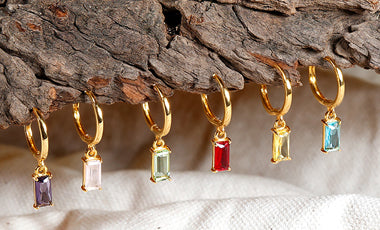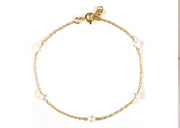What Are Earring Gauges?
Earring gauges measure the thickness of the post that goes through your piercing. The most important thing to remember is that gauge numbers work in reverse—the lower the number, the thicker the earring post.
Here’s a quick breakdown:
- 20G (0.8mm) and 18G (1.0mm) - Standard sizes for lobe piercings.
- 16G (1.2mm) and 14G (1.6mm) - Common for cartilage and body piercings.
-
12G and lower - Used for stretched piercings and body modifications.
Before switching earrings, always check the gauge size to ensure a comfortable fit and prevent irritation or stretching.
Also Read: Stud Earrings for Women: Where to Buy Them?
What Gauge Are Normal Earrings?
Most standard ear piercings follow a common earring gauge range.

-
Lobe Piercings - Typically 20G or 18G, which are thin enough for comfort.
-
Cartilage Piercings - Usually 16G or 14G, providing extra support.
-
Stretched Lobes - Start at 14G or 12G and go thicker over time.
Most professional piercers use 18G or 16G for initial piercings since they allow for more stability. However, some jewelers offer 20G earrings, which are slightly thinner and work well for everyday wear.
What Size Gauge Is a Normal Earring?
If you’re wondering what size gauge is a normal earring, the answer depends on where the piercing is located.
Lobe Piercings:
-
Standard lobe earrings are typically 20G (0.8mm) or 18G (1.0mm).
-
Some high-end jewelers use 22G, which is thinner and more delicate.
-
If your piercing hole has shrunk, a 22G earring may feel more comfortable.
Cartilage Piercings:
-
Most helix, tragus, and rook piercings use 16G (1.2mm) or 14G (1.6mm).
-
A 14G post is thicker, providing more durability for long-term wear.
Body and Stretched Piercings:
-
Stretched earlobes start at 14G and gradually move to 12G, 10G, or thicker.
-
Larger gauges allow for plugs, tunnels, and other body jewelry.
Always check with your piercer before switching to a thicker gauge to avoid discomfort or damage.
What Gauge Is a Normal Lobe Earring?
Lobe piercings are the most common, and their gauge size is fairly standard.
-
Most lobe piercings are 20G or 18G.
-
Some professional piercers use 16G if the person prefers thicker jewelry.
-
If you want smaller, daintier earrings, 22G may be an option.
If you’re wondering what gauge is a normal earring for your lobe, 20G and 18G are the most common choices. If your earrings feel loose or tight, you may need to adjust the gauge size for a better fit.
You May Also Like: What Are the Top Jewelry Trends for 2025: Must-Have Collections
How to Measure Earring Gauge Size?
Measuring the gauge of your earrings is simple and ensures a comfortable fit. Here’s how you can do it:
-
Use a Caliper or Ruler: Measure the thickness of the earring post in millimeters. Then, compare it with a gauge size chart.
-
Check the Manufacturer’s Details: Many jewelry brands list the gauge size in product descriptions.
-
Visit a Professional Piercer: If you're unsure, a piercer can accurately measure your earrings using specialized tools.
-
Gauge Wheels or Cards: These are available at jewelry stores and help determine the size by placing the earring post into different slots.
Knowing your earring gauge size helps prevent discomfort and ensures the perfect fit for your piercing.
How to Choose the Right Earring Gauge?
Selecting the right gauge depends on several factors:

1. Comfort & Fit:
-
If you’re new to earrings, stick to 20G or 18G for standard lobes.
-
For cartilage piercings, 16G or 14G is best for a secure fit.
-
If your piercing hole is shrinking, opt for a higher gauge number (thinner post).
2. Healing & Aftercare:
-
Fresh piercings heal better with a slightly thicker gauge, like 18G or 16G.
-
If your piercing isn’t healing well, switching to a smaller gauge may help.
3. Personal Style:
-
Statement earrings and heavier styles may need 16G or thicker.
-
For a unique look, stretched gauges allow for tunnels and plugs.
If you’re unsure, consult a professional piercer before changing your gauge size.
Read More: What Jewelry Can Food Handlers Wear
Can You Wear a Thicker Gauge Earring?
Yes, but it depends on your piercing. If you want to go from a 20G to a 16G, your piercing will need to stretch slightly. This process should be gradual to prevent discomfort.
How to Safely Switch to a Thicker Gauge:

-
Use lubricated jewelry for an easier transition.
-
Stretch slowly to avoid irritation.
-
Give your piercing time to adjust before trying a thicker post.
If your piercing doesn’t feel comfortable with a thicker gauge, stick with your current size.
Understanding what gauge are earrings helps you choose the right jewelry for your piercings. Most standard earrings are 20G or 18G, while cartilage and stretched piercings require 16G or thicker.
When selecting earrings, always check the gauge size to ensure they fit comfortably. Looking for stylish, high-quality earrings? Rarete Jewelry offers a stunning range of different gauge sizes to match your style. Explore the collection today!
By choosing the correct gauge, you can enhance both comfort and style, ensuring your earrings fit perfectly for any occasion!





